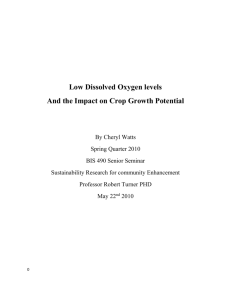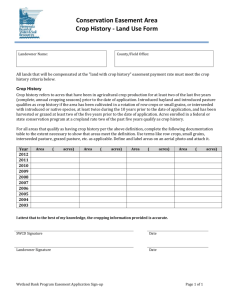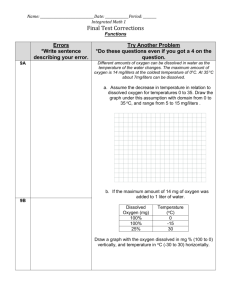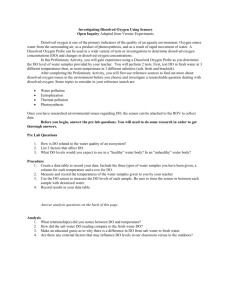Low Dissolved Oxygen Levels in the Well Water and the Impact on
advertisement
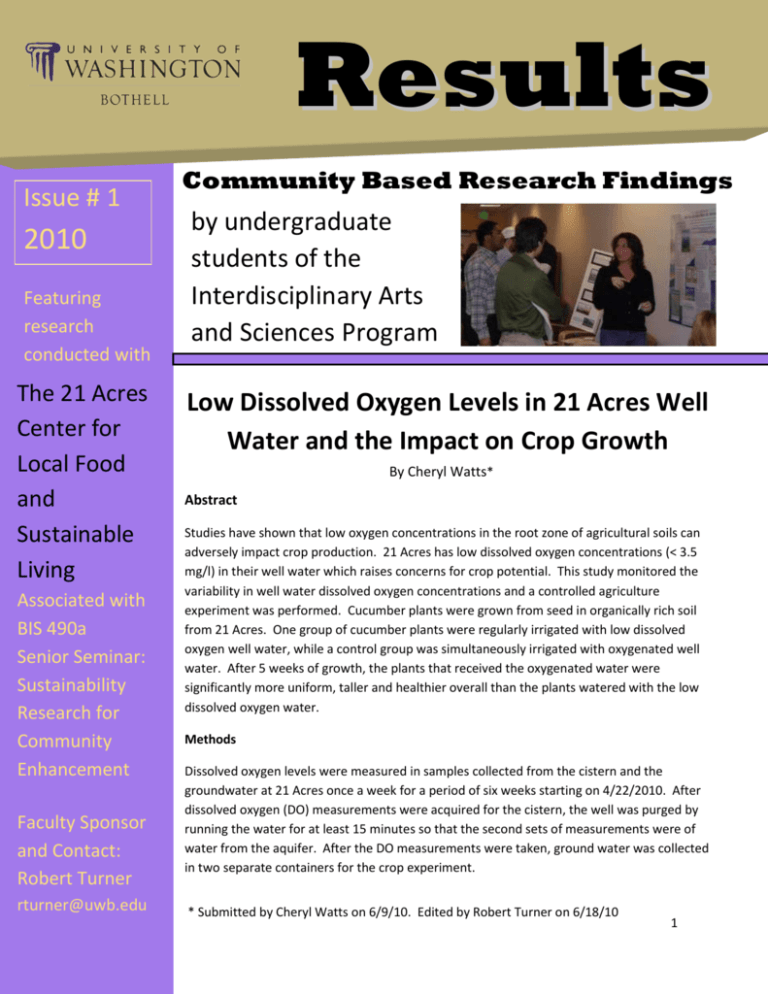
Results Tg Issue # 1 2010 Featuring research conducted with The 21 Acres Center for Local Food and Sustainable Living Associated with BIS 490a Senior Seminar: Sustainability Research for Community Enhancement Faculty Sponsor and Contact: Robert Turner rturner@uwb.edu Community Based Research Findings by undergraduate students of the Interdisciplinary Arts and Sciences Program Low Dissolved Oxygen Levels in 21 Acres Well Water and the Impact on Crop Growth By Cheryl Watts* Abstract Studies have shown that low oxygen concentrations in the root zone of agricultural soils can adversely impact crop production. 21 Acres has low dissolved oxygen concentrations (< 3.5 mg/l) in their well water which raises concerns for crop potential. This study monitored the variability in well water dissolved oxygen concentrations and a controlled agriculture experiment was performed. Cucumber plants were grown from seed in organically rich soil from 21 Acres. One group of cucumber plants were regularly irrigated with low dissolved oxygen well water, while a control group was simultaneously irrigated with oxygenated well water. After 5 weeks of growth, the plants that received the oxygenated water were significantly more uniform, taller and healthier overall than the plants watered with the low dissolved oxygen water. Methods Dissolved oxygen levels were measured in samples collected from the cistern and the groundwater at 21 Acres once a week for a period of six weeks starting on 4/22/2010. After dissolved oxygen (DO) measurements were acquired for the cistern, the well was purged by running the water for at least 15 minutes so that the second sets of measurements were of water from the aquifer. After the DO measurements were taken, ground water was collected in two separate containers for the crop experiment. * Submitted by Cheryl Watts on 6/9/10. Edited by Robert Turner on 6/18/10 1 Results - Community Based Research Findings by undergraduates of the Interdisciplinary Arts and Sciences Program Issue # 1 2010 Methods (continued) For the crop experiment, cucumber seeds, soil and water were obtained from 21 Acres. I planted cucumber seeds in two separate containers. Each container had 16-3inch cells and two seeds were planted in each cell. To water the plants 2 containers were used to collect water from the well at 21 Acres. One was marked A and the other one B. Each sampling period the containers were rotated to avoid the carboy effect. Half of the water for the experiment was oxygenated using a small aquarium pump and air stone. One set of plants received regular (low oxygen) well water and the other set received the oxygenated water. The plants were located in a sunny window and were rotated every couple days to maximize sun exposure. Height measurements of the tallest plant in each cell were done on 5/09/2010, 5/14/2010 and 5/22/2010. The leaf area was measured in square inches on 5/22/09 using the same sample plants in each cell. Statistical analysis was conducted on the results showing mean, standard deviations and confidence interval (Student’s t test). Results The dissolved oxygen levels measured in the 21 Acres well water averaged 1.86 mg/L over the six week time frame (see Figure 1). This is very low compared to levels one would expect in surface waters, but in keeping with dissolved oxygen levels measured in other wells in the Sammamish Valley (1). Surface waters with DO concentrations below 2 mg/l are considered hypoxic and unable to sustain most animal life (2). 3.5 3 2.5 2 1.5 1 0.5 0 Cistern 5/18/2010 5/16/2010 5/14/2010 5/12/2010 5/10/2010 5/8/2010 5/6/2010 5/4/2010 5/2/2010 4/30/2010 4/28/2010 4/26/2010 4/24/2010 Well 4/22/2010 Mg/L Dissolved Oxygen Mg/L Figure 1. Dissolved oxygen levels in Mg/L were consistently low (average DO 1.866 mg/L from the well) with the exception of 5/18/2010 when levels recorded were above 3 mg/L. A controlled experiment was also performed to test the impact of watering cucumber plants with low DO water. On 4/30/2010 cucumber seeds from 21 Acres were planted using organically rich soil from the farm. On 5/4/2010 the plants started to sprout. Right away it was obvious that the plants that were watered with the oxygenated water had some significant differences. They sprouted first, grew at a more uniform rate, and had a broader leaf area. As time went on the oxygenated plants continued to grow taller and more uniform compared to the low DO water plants, which were shorter, more uneven in height, and had a less broad leaf area. The statistical results from this experiment can be seen below in Table 1. 2 Results - Community Based Research Findings by undergraduates of the Interdisciplinary Arts and Sciences Program Issue # 1 2010 Results (continued) May 9, 2010 May 14, 2010 May 20, 2010 May 22, 2010 Plant Height Oxygenated Well Water Plant Height Low-Oxygen Well Water (inches) (inches) P-Value 2.24 ± 0.36 a 2.72 ± 0.36 a 3.26 ± 0.46 a 1.72 ± 0.41 b 2.19 ± 0.51 b 2.94 ± 0.61 a P = 0.00032 P = 0.00095 P = 0.05351 Leaf Area Oxygenated Well Water Leaf Area Low Oxygen Low-Oxygen Well Water P-Value (inches squared) (inches squared) 1.25 ± 0.13 a 1.10 ± 0.29 b P= 0.041 Table 1: Mean values for height in inches of cucumber plants watered with oxygenated well water and plants watered with low DO well water on three separate dates. Means (n=16) are shown ± 1 Standard Deviation. Note the uniformly larger standard deviations for the plants treated with low DO water. Different letters (a,b) indicate significant difference (p < 0.05) between plants watered with oxygenated well water and plants watered with low DO well water by Student’s t-test. Same letters (a,a) indicate no significant difference using student’s t-test. Conclusions There are consistently low levels of dissolved oxygen in the well water at 21 Acres, which is apparently common for the shallow sedimentary aquifers in the Woodinville area (1). Based on previous studies (3) and the experiment conducted in this study, irrigating crops with this well water has the potential to reduce both crop yields and quality. The cucumber plants that were irrigated using oxygenated well water were more uniform, taller, and had a broader leaf area than their counterparts irrigated with unadulterated 21 Acres well water. It is recommended that 21 Acres oxygenate their well water prior to irrigating and that further experiments be conducted to better assess the quality of the 21 Acres well water and its potential impacts on agriculture and other uses. Bibliography (1) King County Water and Land Resources Division, 2010. Groundwater Data Search, Well ID: SAMM W7A, Measurement Date 5/27/2003 . Retrieved on June 1st, 2010. http://www5.kingcounty.gov/groundwater/Details.aspx?Equis_ID=SAMM_W7A (2) Committee on Environment and Natural Resources, 2000. Integrated assessment of hypoxia in the Northern Gulf of Mexico: National Science and Technology Council, 58 p. (3) Holtman, W., Van Duijn, B., Blaakmeer, D., Blok,C., 2005. Optimalization of oxygen levels in root systems as effective cultivation tool. International Symposium on Soilless Culture and Hydroponics. Retrieved on May 2, 2010: http://www.actahort.org/books/697/697_5.htm To learn more about community based research at the University of Washington Bothell, or to propose 3 partnerships that could engage our students, contact Karen Ericson, Director of Community-Based Learning and Scholarship at kericson@uwb.edu or 425-352-3365. Or visit our web site at: http://www.uwb.edu/cbls. 3
